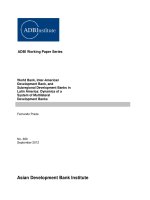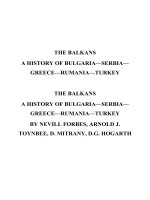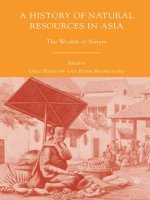Playing in Isolation: A History of Baseball in Taiwan ppt
Bạn đang xem bản rút gọn của tài liệu. Xem và tải ngay bản đầy đủ của tài liệu tại đây (1.26 MB, 250 trang )
PLAYING IN ISOLATION
JUNWEI YU
A HISTORY OF BASEBALL IN TAIWAN
PLAYING IN
ISOLATION
University of Nebraska Press • Lincoln & London
© 2007 by the Board of Regents
of the University of Nebraska
All rights reserved
Manufactured in the
United States of America
Library of Congress Cataloging-
in-Publication Data
Yu, Junwei.
Playing in isolation : a history of
baseball in Taiwan / Junwei Yu.
p. cm.
Includes bibliographical
references and index.
isbn-13: 978-0-8032-1140-7
(cloth : alk. paper)
isbn-10: 0-8032-1140-6
(cloth : alk. paper)
1. Baseball—Taiwan—History.
2. Baseball players—Taiwan—
History. I. Title.
gv863.795.a1y8 2007
796.35709512Ј49—dc22
[B]
2006100127
For my parents,
Yu Minxiang and Zeng Yueer,
who offered unconditional support to me,
thus making this project possible.
CONTENTS
List of Illustrations . . ix
Preface . . xi
Acknowledgments . . xv
List of Abbreviations . . xviii
Note on Romanization of Chinese Names . . xix
Introduction . . 1
chapter 1
Wooden-Ball Finds a Home, 1895–1945 . . 11
chapter 2
The Golden Era of Baseball, 1946–1967 . . 25
chapter 3
The Myth of Hongye and the llb Championship, 1968–1974 . . 37
chapter 4
A Drastic Decline in Baseball’s Population, 1975–1989 . . 64
chapter 5
The Birth of Professional Baseball, 1990–1995 . . 91
chapter 6
Multiple Crises, 1996–2001 . . 115
chapter 7
The 2001 World Cup: A Turning Point? . . 144
Conclusion . . 165
appendix 1
Taiwanese teams in Little League (under-13) . . 169
appendix 2
Taiwanese teams in Senior League (age 13–15) . . 170
appendix 3
Taiwanese teams in Big League (age 16–18) . . 171
appendix 4
iba under-19 competition . . 172
appendix 5
Taiwanese players signed by Japanese pro
clubs before the cpbl . . 173
appendix 6
Taiwanese players signed by Japanese and Korean
amateur clubs after World War II . . 174
appendix 7
Sentences and fi nes for pro baseball gambling
and match-fi xing in 1997 . . 175
appendix 8
Twenty-seven players suspected of match-fi xing but
released for lack of evidence . . 178
appendix 9
Taiwanese players signed by foreign pro clubs
after the creation of the cpbl . . 179
Notes . . 183
Bibliography . . 197
Index . . 205
viii Contents
ILLUSTRATIONS
Following page 90
1. Broadcasting games during the Japanese occupation
2. Jianong’s glorious return to school
3. Commemorating Jianong’s forty-inning marathon, 1941
4. Members of the Seventh Fleet holding a Taiwan Coal souvenir, 1952
5. U.S. Major General William Chase presenting
the Golden Statue award
6. Players in the 1954 Children’s Cup
7. The Taiwan Land Bank dugout during the 1954 Bank and
Corporation Union Cup
8. Fans pack Taiwan Municipal Stadium for the
Fourth Asian Championship
9. Sadaharu Oh, 1965
10. Hongye’s catcher Jiang Honghui’s grand slam
11. Hongye heroes Jiang Honghui and Jiang Wanxing
12. U.S. Major General Ciccolella donating money
to the Jinlong youth team
13. A victory parade celebrating Juren’s winning
the 1971 llb world series
14. The national team and staff after the 1983
Asian Championship campaign
15. The 1992 Olympic squad
16. Chen Jinfeng (Chen Chin-feng) signs with
the LA Dodgers in 1999
17. Fans of the Brother Elephants
18. The Brother Elephants celebrating their second-half
season title in 2003
19. Sign forbidding the playing of baseball
20. Members of the team that defeated Cuba in the
1983 Intercontinental Cup
x Illustrations
PREFACE
Ever since Taiwan captured its fi rst Little League Baseball world series
title in 1969, baseball has been a sport in which the Taiwanese people
have taken deep pride. Over the next twenty-seven years Taiwan ap-
peared in the annual tournament twenty-one times and captured sev-
enteen titles.
I have followed Taiwanese national teams since I was small. Like
many fellow islanders, I watched live Little League tournament games
on television late into the night as I sipped instant noodles, a favorite
snack in Taiwan. Thankfully, tournaments were held during summer
vacations so that I didn’t have to worry about school. I was fi lled with
excitement and joy at that time, but as I grew older and learned more
about the inner world of baseball, I found the game no longer as sim-
ple and beautiful as it had once seemed.
My interest in baseball research was sparked by playing amateur
baseball during senior high school. As with just about every high
school in Taiwan, mine did not have a formal baseball program. Thus
for three years my classmates and I organized games in the sports fi elds
behind our school until one day the principal posted a sign on the
fence that read “Baseball, softball, and other dangerous sports are for-
bidden.” Such signs are frequently posted in Taiwanese schools, the
common notion being that baseball, unlike running or swimming, is
quite unsafe.
Unable to play the game I loved, I found alternative ways to be
around the diamond. At many amateur baseball games I had the op-
portunity to talk extensively with players, coaches, and other individu-
als who were deeply involved in the sport. In 1997 I was the scorer
for the under-16 International Baseball Federation competition, which
was my fi rst contact with government offi cials involved in the game.
In 2001, thanks to help from friends, I was fortunate enough to be the
U.S. team’s interpreter during the baseball World Cup.
Eventually my deep fascination with all things baseball led to my
adoption of the game for my PhD dissertation, in which I explored
politics in Taiwanese baseball. This current book has been adapted
from that work, as well as drawing upon recent events in Taiwanese
baseball and from my lifelong obsession with the sport. Relying on
thousands of hours of formal and not-so-formal research and inter-
views, I present an alternative perspective on Taiwanese baseball to the
one commonly held on the island. The Taiwanese public tends to view
governmental intervention in sports, specifi cally baseball, as good and
special physical education classes as normal. But in this book I argue
that it is such practices that led to the decline of Taiwanese baseball.
To understand fully the development of Taiwanese baseball, one
must have some knowledge of the island’s history. Taiwan’s geographic
location has made it a strategic base for those who sought access to
China and for China when it wished to exert its infl uence over the
Pacifi c Rim. Consequently, the island has changed hands many times.
Because each ruling people possessed a different culture and language
and represented a different ethnic group, each period of Taiwanese his-
tory has had its own unique characteristics.
It was one such ruling people, the Japanese, who introduced base-
ball to Taiwan in the early twentieth century. By the time Japan had
ended its Taiwanese rule, thousands of islanders played the game.
The sport continued to gain popularity after the Kuomintang re-
gime arrived. The level of participation was highest during this era,
especially for adult baseball. Still, antiphysical Confucian ideas did
prevent some parents from allowing their children to play baseball but
not all since schools required athletes to study.
Grassroots baseball reached its peak in the 1970s because of the suc-
cess of Little League teams at Williamsport and to the fame and for-
tune bestowed on successful Little League players, thanks in large part
to the baseball policies of the Kuomintang. Despite these factors, an-
other decline in baseball’s popularity followed, with the lowest level of
baseball participation occurring during the 1980s. During this decade
many of the incentives disappeared, Confucian ideas resurfaced, and
xii Preface
widespread reports of corruption in baseball soured parents’ attitudes
toward the game.
Against such a complex background, baseball, the largest spectator
sport on the island, has been given specifi c meaning and purpose ac-
cording to who has been in power. Thus, an overarching goal of this
book is to trace the development of the game and the cultural and
political forces that have infl uenced public perception of the sport. I
chose to take a chronological approach because it best illustrates the
dramatic swings in popularity of the game. Each chapter therefore cov-
ers a period in Taiwanese history that profoundly affected the game.
To date no academic work has explored Taiwanese baseball in its
social, cultural, and political settings. In this book I will present a
balanced view of Taiwanese baseball, even discussing thoroughly the
cheating and corruption that have plagued the game. Because of the
latter portrayal I have already felt pressure from island baseball author-
ities telling me not to expose the underbelly of our national pastime.
However, I believe that my actions are justifi ed and that only by see-
ing the dark side of the sport can the baseball world begin taking this
negative side seriously, rather than turning a perpetual blind eye to the
problems of baseball on Taiwan.
Preface xiii
ACKNOWLEDGMENTS
I have been watching baseball since childhood, but it was Lincoln Al-
lison, my PhD supervisor at Warwick University, who gave me the
intellectual guidance needed to research Taiwanese baseball. The depth
of gratitude and respect I have for him is immense. Other teachers,
such as Terry Monnington and Ken Foster, at the Center of Sport in
Society also deserve my thanks.
Further, this book would not have been started without the interest
and enthusiasm shown by the University of Nebraska Press, to whose
editors I am grateful for their consistent patience and support. I am
especially indebted to Sara Springsteen and Rob Taylor, who acted
on behalf of the press. Michael Haskell of Columbia University Press
copyedited my manuscript, making it more readable. Most important
of all was Dan Gordon, who spent hundreds of hours developmentally
editing the manuscript.
I am indebted to both the Brother Elephants pro club and the
Chinese Taipei Baseball Association. Jianong alumnus Cai Wuzhang
deserves special thanks for not only providing valuable insights into
Taiwanese baseball during the Japanese occupation but also offering
precious information about the early development of Taiwanese base-
ball that is rare and diffi cult to obtain. Thanks go also to the Central
News Agency for invaluable photographs that add color to this book.
My gratitude goes as well to such friends as Zeng Wencheng who
helped me sift through ideas and provided intellectual support and
friendship. George Gmelch of Union College offered advice. Riccardo
Schiroli, Harry Wedemeijer, and Michal Hanus provided insight into
European baseball, while Jamey Storvick talked about his scouting ex-
perience in Asia.
During my fi eldwork in pursuit of this project, my associates in Tai-
wan were very helpful. I wish to offer sincere thanks to the many insti-
tutions and individuals who have provided assistances. Yang Rongjian
and Huang Guanxiong, both of whom are responsible for www.play-
ballx.com and who gave me the opportunity of being a trainee re-
porter, thus enabling me to interview players and coaches without the
slightest problem. Zhang Huiyan, Yang Renjie, Lin Guanhong, Zhai
Zhengming, Lin Haoqiang, Zhong Mengwen, and Qiu Wenyuan and
other friends on telnet://bbs.aidsbbs.net provided additional informa-
tion needed for this work.
Special thanks go to my interviewees Xu Weizhi, Tang Panpan,
Peng Chenghao, Li Juming, Lin Huawei, Wei Laichang, Cai Qida,
Lin Zongcheng, Xu Yashu, and Jonathan Hurst, as well as to several
anonymous interviewees, all of whom have made a lifetime of contri-
bution to baseball and all of whom provided important insights into
the game.
Thanks also go to the students majoring in athletic training and
health at the National College of Physical Education and Sports. They
offered invaluable information about medical treatments of Taiwanese
players, many of whom suffered serious injuries due to overuse during
their careers.
Additionally, I offer my appreciation to the staff of the National
Library for teaching me how to use microfi che and for solving me-
chanical problems while operating microfi che readers. The time and
the money spent on watching and printing out old materials supplied
a solid foundation for the project. In addition my subscription to the
Society for American Baseball Research enabled me to gain access
through ProQuest to several old newspapers, each of which offered me
insights into Taiwanese baseball.
In this litany of thanks my family deserves my deepest gratitude.
Over the years my parents Yu Minxiang and Zeng Yueer have given
me constant encouragement and unconditional support, both spiritu-
ally and fi nancially. This book would not exist without their love and
assistance.
Finally, I would like to thank the following people: Zeng Weilin,
Zhong Mingfeng, Xie Shiyuan, Xie Jiafen, Lan Peiyu, Cao Peiying,
Chen Liangyue, Liao Fanbei, Wu Xuzhe, Qiu Guangzong, Huang Xi-
xvi Acknowledgments
uyu, Huang Suyu, Lin Shuxian, Hong Jinfu, Cai Kunzhen, Xu Heling,
Xu Yashu, Cheng Ruifu, Lin Jianyu, Li Bingzhao, Chen Liangyue, Cai
Youlin, Lin Guanghong, Zhang Sheng, Chen Xianwei, Zhang Huiyan,
Yang Zhiguo, Lin Jiang, Huang Zhaoxi, Tang Zhimao, Andrew Mor-
ris, Wang Jiaan, Wang Yueyu, Tu Youcheng, Wei Ziyao, Qiu Guobin,
Leslie R Kriesel, Qi Laiping, Su Yanzhang, Huang Min, Fan Hong, Yu
Bowei, and Yu Jiayi.
Acknowledgments xvii
ABBREVIATIONS
bcuc Bank and Corporation Union Cup
cba Chinese Baseball Association
cbl China Baseball League
cpbl Chinese Professional Baseball League
ctba Chinese Taipei Baseball Association
iba International Baseball Association
ioc International Olympic Committee
kmt Kuomintang (Nationalist Party)
llb Little League Baseball
maag Military Assistance and Advisory Group
npb Nippon Professional Baseball
pony Protect Our Nation’s Youth
prc People’s Republic of China
roc Republic of China
rsea Retired-Serviceman Engineering Agency
sbl School Baseball League
tml Taiwan Major League
NOTE ON ROMANIZATION OF CHINESE NAMES
There are four common ways to render Chinese names into English: (1)
the Pinyin system used by mainland China; (2) the Wade-Giles system
invented by the Qing dynasty and used on Taiwan; (3) the Tongyong
system developed during the late 1990s and used on Taiwan; and (4)
idiosyncratic spellings and English Chinese name combinations ad-
opted by individuals (for example, P. P. Tang). The situation on Taiwan
is very confusing because all four types of romanization are used on
the island. A foreigner can easily get lost on Taiwan because the names
of roads and streets are often written using one system along one
stretch but written in another system along another section. Likewise,
the same person can appear to have three different names depending
upon the system being used to spell that name. The United Nations
accepted the Pinyin system as a standardized Mandarin romanization
system in 1986. Thus, to avoid confusion, the entire book will use the
Pinyin style. For example, U.S based players Tsao Chin-hui and Chen
Chin-feng are written as Cao Jinhui and Chen Jinfeng, respectively.
However, because of common usage, some names and terms will be
rendered using traditional spellings. Thus the reader will encounter
Chiang Kai-shek, Taipei, and the names of Chinese Professional Base-
ball League teams, among others.
INTRODUCTION
T
he fi rst Europeans to reach Taiwan came in the early sixteenth
century and were Portuguese sailors, who called the place Ilha
Formosa (Beautiful Island). The island’s name was possibly more
appropriate in the days when it was covered by virgin forest and not by
the factories of the present day.
Taiwan lies off China’s coast, separated from the mainland by the
Taiwan Straits. Shaped roughly like a tobacco leaf, the island is about
two hundred and fi fty miles long and at its broadest point around
ninety miles wide. The Central Mountain Range bisects Taiwan from
north to south, and about two-thirds of the island is covered with
forested peaks. The island enjoys an oceanic and subtropical monsoon
climate infl uenced by its topography. Summers are long and accom-
panied by high humidity, while winters are short and usually mild.
Generally speaking, weather and climate render the place eminently
suitable for baseball.
From the popular pickup games in the eastern provinces to the pro-
fessional outings in Taipei of such teams as the Brother Elephants,
island baseball has developed a culture that is uniquely Taiwanese. At
the ballparks, which are comparable in size to Minor League stadiums
in the United States, players chew watermelon seeds, fans bang drums,
and cheerleaders sing songs through a microphone for the entire game.
Fans also hang pineapples outside the home team’s dugout when the
team suffers a losing streak. This custom derives from the Taiwanese
for “pineapple,” wanglai, which means “bring us good luck.” Some-
times whole teams are brought to Buddhist or Daoist temples to wor-
ship and ask for good luck. One may label this practice as superstition,
but it is a part of Chinese culture. Large groups of diehard Internet
fans, such as the Internet Elephants, attend games together. Alcohol
2 Introduction
is rarely consumed at Taiwanese games; vendors sell local Taiwanese
delicacies, such as Taiwanese fried chicken, oyster omelets, pigs’ blood
cakes, Taiwan sausages, and pearl milk tea (tapioca milk tea).
Uniquely Taiwanese is also the custom among players of making
and drinking tea to calm their nerves after an exciting or exhausting
game. Some players spend large sums of money for tea sets that pro-
duce a high-quality tea. Typically one player prepares the tea, and his
teammates surround the table, talking and chatting. The occasion be-
comes a small social gathering.
In the clubhouse players rarely use Mandarin, the island’s offi cial
language, but rather speak Taiwanese, which is a dialect of Chinese.
The reasons for using this dialect can best be understood from an out-
line of Taiwanese politics and culture.
Demographics
Taiwan has a population of roughly twenty-three million, making the
population density the second highest in the world after Bangladesh.
About fi fty-nine percent of the population is concentrated in four
cities: Taipei, Gaoxiong, Taizhong, and Tainan. Four ethnic groups
inhabit the island: aboriginal peoples, Fujianese, Hakka, and main-
landers. The latter three belong to the same Han-speaking family of
immigrants.
The eastern part of Taiwan has the highest proportion of aborigi-
nes on the island. These people, who came from southern China and
Austronesia, comprise thirteen ethnic groups, with their population of
four hundred and fi fty thousand accounting for only about two per-
cent of the total Taiwanese population. There are large differences in
the size of each aboriginal group, which are spread over a large area.
The aboriginal peoples have been marginalized and isolated politi-
cally, economically, and culturally. Indeed, it was only a century ago
that the tribal societies were integrated into the system of the modern
nation. Consequently, the aborigines constitute an underclass and are
overrepresented in the ranks of the socially and economically disen-
franchised. For them baseball has become a means for social and eco-
nomic advancement.
Spread throughout the rest of Taiwan are the Fujianese and the
Introduction 3
Hakka, descended from Chinese settlers that began arriving on the
island some six hundred years ago. The fourteen million Fujianese
make up approximately seventy percent of Taiwan’s population, and
the three million Hakka account for around fi fteen percent.
The fi nal group, the mainlanders, are Taiwan’s newcomers. The
mainlanders arrived in 1949 when Kuomintang or Nationalist Party
(kmt) military troops and their followers from every province in China
migrated to the island in what may be the largest elite immigration of
the last century. The mainlanders’ two and a half million account for
eleven percent of Taiwan’s entire population.
The Han Chinese imported their culture with them. Thus the reli-
gious and cultural life of Taiwan is dominated by a polytheistic blend
of ancestor worship, Buddhism, Daoism, and folk religions. Buddhism
is the most popular religion, with approximately three and a half mil-
lion followers and over four thousand temples. Daoism is viewed as
an indigenous religion and has around four and a half million practi-
tioners.
Although viewed by many foreigners as a religion, Confucianism
is more a philosophy than a religion. Accordingly, Confucian temples
are halls to honor Confucius rather than places of worship. A main
tenet of Confucianism is respecting seniority in the family. Further,
social roles and children’s obligations to do well in academic study are
strongly emphasized, especially in Han Chinese families. As a result,
Confucianism cultivated an antiphysical or sedentary culture that pro-
foundly affected the development of sports in Taiwanese society. The
Confucian infl uence will be thoroughly examined in later chapters.
History
The root of Taiwanese population and cultural diversity lies in the
island’s history, marked by the arrival of several waves of immigrants.
Taiwan was originally settled by the ancestors of the aborigines, who
inhabited the low-lying coastal plains of the island. They called the
island Pakan. From the fourteenth century through the eighteenth,
the aborigine peoples were joined by large numbers of Chinese settlers
from the Holo-speaking province of Fujian and the Hakka-speaking
province of Guangdong. Although they were Han Chinese, their pur-
4 Introduction
pose for emigrating was not for territorial expansion of China but to
fl ee local living conditions and taxes.
Throughout the Ming Dynasty (1368–1644) Taiwan was insignifi -
cant in the eyes of the imperial government, who had no intention
of claiming sovereignty over the island. The imperial court was busy
countering the threat posed by the northern nomads, especially the
Mongolians.
This lack of mainland interest permitted foreign powers to set up
trading stations in Taiwan. In 1642 the Dutch East India Company, for
example, as a part of Holland’s expanding global mercantile activities,
established a fortress named Fort Orange on Taiwan. First, however,
the Dutch had to drive out the Spanish, who had occupied the north-
ern part of Taiwan.
Two years later a leading Ming general named Zheng Chenggong
(also known as Koxinga) decided to cross the straits to occupy Taiwan.
Zheng had suffered a crushing defeat at the hands of the Manchus, who
then established the Qing Dynasty in China in 1644. Zheng planned
to use Taiwan as a base from which eventually to recover the mainland.
His fl eet landed on the island and eventually drove out the Dutch in
1662. Zheng’s motto, “Overthrow Qing, Restore Ming,” made him a
sacred symbol and a national hero for the kmt three centuries later.
The reign of the Zheng family on Taiwan fi nally ended when they
surrendered to the Qing Dynasty, who launched a surprise attack on
the island in 1683.
Over the next two centuries the increasingly sinicized Manchus pro-
moted Confucian practices on Taiwan. As Han Chinese families and
permanent settlements grew during the nineteenth century, life on the
island gradually came to resemble that of the mainland. Some island
families had their sons trained in classical learning in order to enable
them to take civil service examinations and thereby enter the state bu-
reaucracy, which held the most cherished status in Chinese society.
After nearly two hundred years of peace and self-suffi ciency, China
suffered a series of humiliations infl icted by foreign powers. Most im-
portantly for Taiwan, in 1894 China was defeated by Japan and ceded
the island to the victor. As a result, Taiwan’s development diverged
from that of China, and it was during the fi fty-year Japanese occupa-









